49 Flowers in Vietnamese || Symbolism & Legends Uncovered
Flowers in Vietnamese & Their Cultural Meaning (PLUS 19 Bonus Words)
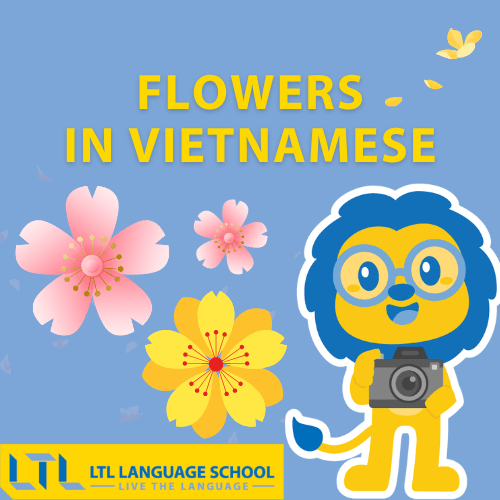
Welcome to another vocabulary article, where you’ll learn plenty of new words you can start using in your daily life.
We will teach you about flowers in Vietnamese and what they symbolise in the Vietnamese culture.
What do unique meanings do flowers have in your country? Let us know in the comments 🌸
First things first! Flower in Vietnamese is Hoa.
Flowers in Vietnamese || Vietnam National Flower
Flowers in Vietnamese || Other Flowers & Symbolism
Flowers in Vietnamese || Tet Flowers & Legends
BONUS || Plants in Vietnamese
Flowers in Vietnamese || FAQs
Flowers in Vietnamese || Vietnam National Flower
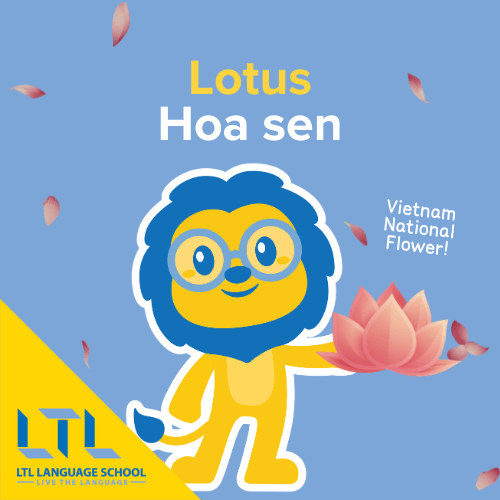
Let’s start with the most important flower of all.
The national flower of Vietnam is the Lotus.
Lotus in Vietnamese is Hoa sen.
The lotus holds immense cultural significance in Vietnamese society.
It is highly regarded for its symbolic representation of purity and enlightenment.
Despite growing in muddy waters, the lotus emerges it all of its beauty, symbolising the ability to rise above adversities, be resilient and maintain a pure spirit.
Additionally, different colours of lotuses are believed to signify different meanings. For example, white more strongly symbolizes purity, whilst blue can be symbolic of wisdom.
A fun fact about lotuses is that at night time, the flowers close and sink beneath the water, before surfacing and reopening with the daylight.
NOTE || In Vietnamese cuisine, the lotus is used as the main ingredient for many traditional dishes.
Flowers in Vietnamese || Other Flowers & Symbolism
Just like the lotus, many other flowers hold great significance in the Vietnamese culture.
Let’s see a few of them.
Chrysanthemum
Chrysanthemum in Vietnamese is Chi cúc.
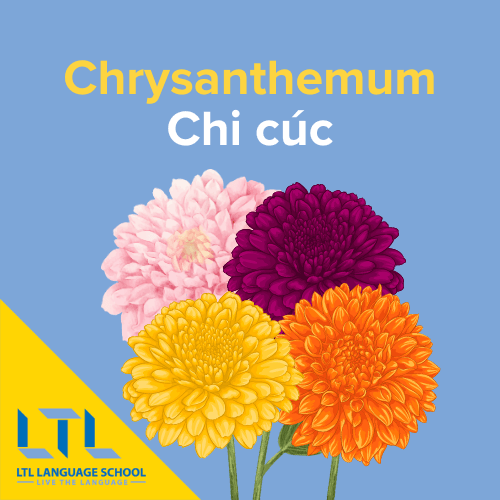
Chrysanthemums also hold a special place in Vietnamese culture.
They are highly appreciated for their beauty, symbol of resilience and well-being, as well as their therapeutic properties.
They are considered symbols of longevity, vitality, and endurance and are commonly featured in Vietnamese art, including paintings, calligraphy, and pottery.
Moreover, chrysanthemum flowers can be turned into tea, and is believed to have various health benefits, including improving digestion, reducing inflammation, and boosting the immune system.
The aroma and taste of chrysanthemum tea are cherished by many Vietnamese people.
Rose
Rose is Vietnamese is Hoa hồng.
Roses have a significant presence in Vietnamese culture, symbolizing love, beauty, and passion.
Roses are commonly associated with romance and are often given as gifts on special occasions such as Valentine’s Day, anniversaries, and weddings.
They convey deep emotions and affectionate sentiments. Vietnamese literature, music, and poetry frequently reference roses as symbols of love and longing.
It is said that each colour has its own significance as well:
- The red rose expresses deep love
- The white rose expressed humble and pure love
- The pink rose symbolises delicate women of Vietnam
- The yellow roses are generally gifted to friends to show affection
The beauty and allure of roses have also influenced Vietnamese fashion and design, with rose motifs frequently appearing in fabrics, embroidery, and accessories.
In Vietnamese culture, roses are cherished as timeless symbols of love, elegance, and emotions.

23 Colors in Vietnamese 🎨 Discover Their Meanings (+ Bonus Quiz)
An important part of learning any language is learning the colors… so today we teach you 21 different Colors in Vietnamese (+ including a FREE Quiz).
Sunflower
Sunflower in Vietnamese is Hoa hướng dương.
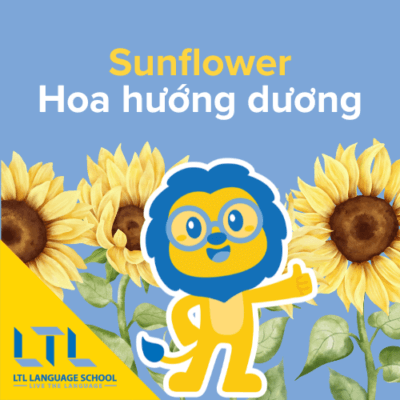
In Vietnamese culture, the sunflower is often associated with positivity, joy, and warmth.
Its bright yellow petals resemble the sun, symbolizing vitality, optimism and happiness.
The sunflower’s tall stature and ability to face the sun throughout the day have made it a metaphor for strength, resilience, and unwavering determination.
In recent years, sunflower fields have become popular tourist destinations, particularly in the central provinces of Vietnam, attracting visitors who are captivated by the sea of golden blooms.
Lily
Lily in Vietnamese is Hoa loa kèn.
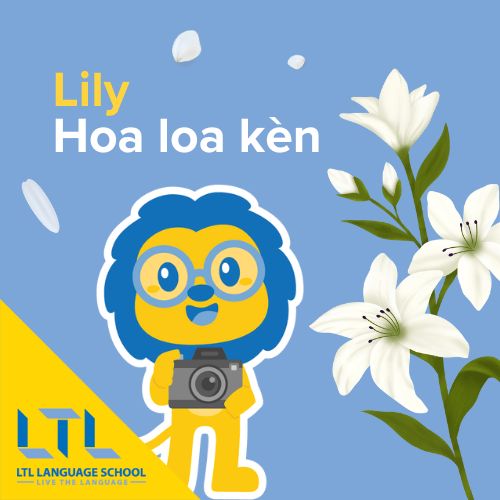
Lilies are admired for its elegance, purity, and spiritual connotations.
In Vietnamese tradition, the lily is often associated with funerals and mourning, representing the departure of the soul to the afterlife.
It is commonly used as a symbolic offering during memorial services and ceremonies to honour the deceased, along with other flowers (white is the preferred colour) such as chrysanthemums, orchids and carnations.
The white lily, in particular, is regarded as a symbol of innocence, purity, and spiritual enlightenment.
Beyond its association with mourning, the lily is also celebrated for its beauty and is used in various festive occasions and celebrations, such as for wedding bouquets and decorations.
The lily’s symbolic significance in Vietnamese culture highlights its dual nature of representing both mourning and celebration, making it a revered and cherished flower.
Orchid
Orchid in Vietnamese is Phong lan or Hoa lan.
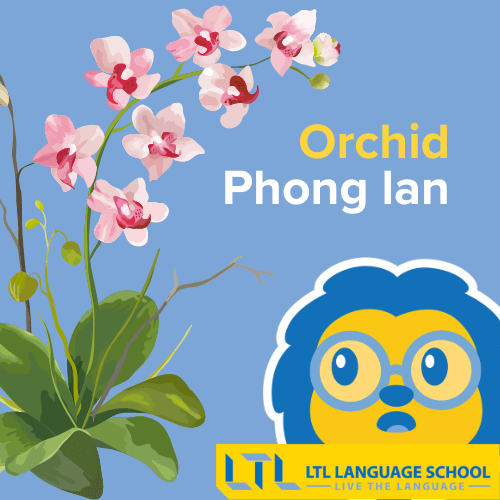
Orchids represent beauty, elegance, and refinement.
In Vietnamese traditions, orchids are associated with nobility and grace, symbolising high social status and sophistication.
Orchids have a long history of cultivation and are particularly cherished in Vietnamese gardens and homes.
The art of cultivating and arranging orchids, known as “cây cảnh,” is deeply ingrained in Vietnamese horticulture and is considered a true art form.
Orchids are also offered during memorial services and funeral ceremonies to honour the deceased.
Other flowers
Now that we’ve seen flowers holding specific symbolism, here is a summary of the flowers mentioned previously, as well as many others worth learning.
Let us know in the comments which is your favourite!
| English | Vietnamese |
|---|---|
| Apricot flower | Hoa Mai Vàng |
| Begonia | Thu hải đường |
| Bellflower | Hoa chuông |
| Chamomile | Hoa cúc La Mã |
| Chrysanthemum | Chi cúc |
| Dahlia | Thược dược |
| Dafodil | Daffodil |
| Daisy | Hoa tiểu cúc |
| Dandelion | Bồ công anh |
| Hibiscus | Hoa dâm bụt |
| Iris | Chi diên vĩ |
| Jasmine | Hoa lài |
| Japan rose | Nhật Bản tăng |
| Juniper | Cây bách xù |
| Lavender | Hoa oải hương |
| Lily | Hoa loa kèn |
| Lotus | Hoa sen |
| Magnolia | Chi mộc lan |
| Marigold | Cúc Vạn Thọ |
| Orchid | Phong lan/ Hoa Lan |
| Pasque flower | Hoa Pasque |
| Peach Blossom | (Hoa Dao) |
| Peony | Hoa mẫu đơn |
| Pink musk | Xạ hương hồng |
| Plum flower | Hoa Mận |
| Rose | Hoa hồng |
| Saffron | Nghệ tây |
| Sunflower | Hoa hướng dương |
| Tulip | Hoa tulip |
| Violet | Hoa violet |
Flowers in Vietnamese || Tet Flowers & Legends
Vietnamese Tet Holiday or “Tết Nguyên Đán” is the most important celebration in Vietnamese culture, and is essentially the Vietnamese New Year celebration.
Two types of flowers specifically are prominently used during this time to symbolise good luck, prosperity, and new beginnings.
Let’s have a look at them:
Yellow Apricot Flowers
The yellow apricot flower in Vietnamese is Hoa mai vàng.
The yellow apricot flowers are one of the most important flowers during Vietnamese New Year, as they symbolise luck and prosperity.
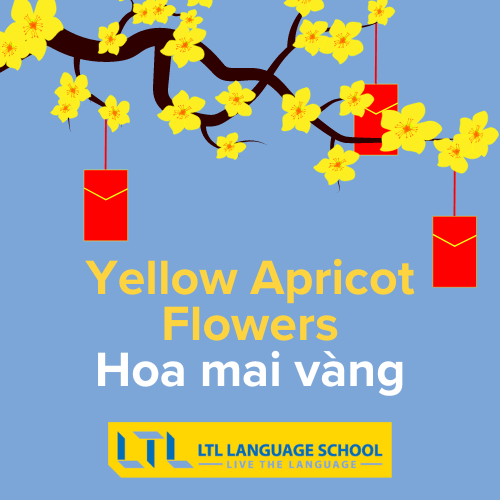
They are are commonly displayed in homes, shops, and public spaces throughout the Tet season.
The yellow apricot flower comes with a Vietnamese legend that adds to its cultural significance:
There was a courageous girl named Mai, whose father trained her in martial arts.
Together, they vanquished a devil tormenting the villagers, but the devil managed to fatally wound Mai.
Touched by her bravery and her mother’s sorrow, the Kitchen God pleaded with the Jade Emperor to bring Mai back to life for nine days.
The Jade Emperor granted the request, allowing Mai to return to her family annually from December 28 to January 6 of the lunar calendar.
As the girl’s family members passed away, Mai transformed into a flowering tree, blossoming at the temple where she was worshipped.
This tree, known as “Mai,” displayed yellow flowers for nine days during the Tet holiday, deterring devils and spirits from disrupting the festivities.
Peach Blossom
The peach blossom in Vietnamese is Hoa đào.
Peach flowers represents auspiciousness, luck, new beginnings and are believed to scare away evil spirits.
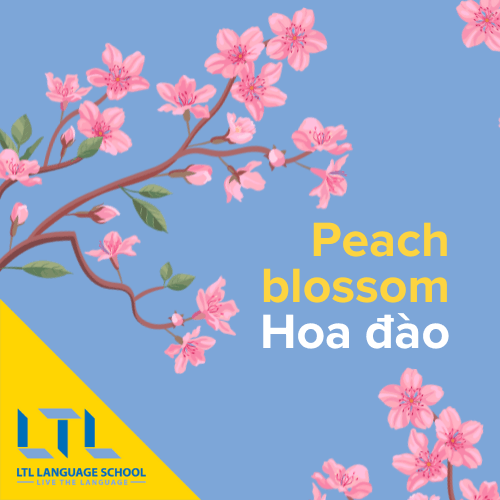
The blossoms symbolise vitality and prosperity, and signifies the arrival of spring and the start of a new year.
In Vietnamese culture, peach flowers are believed to bring good luck and fortune for the upcoming year.
Displaying peach flowers during Tet is seen as a way to invite positive energy and blessings into the household.
There is also a legend associated with peach flowers, which explains why it is believe to scare spirits off. It is as follow:
In the past, there was a large peach tree located in the eastern part of Soc Son mountain.
This tree had expansive branches that provided ample shade. Two gods named Tra and Uat Luy resided on the tree, and they were known for their protective powers over the people living in the region.
The presence of these two gods instilled fear in any devils or ghosts that dared to disturb humans. The devils and ghosts were particularly fearful of the peach tree itself.
However, towards the end of each year, like other gods, Tra and Uat Luy had to ascend to heaven to meet the Jade Emperor.
During the period when the two gods were absent from the world, which coincided with the New Year celebration, the people devised a plan to prevent the devils and ghosts from causing trouble.
They would break off peach blossom branches and place them in jars on altars.
The sight of the peach blossom branches frightened the devils and ghosts, deterring them from approaching.

A Beginner’s Guide to Weather in Vietnam
Due to its layout and wide range of various landscapes and terrain, the weather in Vietnam changes considerably depending on where you are travelling.
Bonus Vocabulary || Plants in Vietnamese
Let’s finish this article with some bonus vocabulary about plants in Vietnamese!
The most important word here:
Plant in Vietnamese is Thực vật
If you are like me and have a dozens of succulents at home, you’ll want to learn the word for that as well:
Succulent plant in Vietnamese is Cây mọng nước.
Here we’ve got some common words regarding trees in Vietnamese:
| English | Vietnamese |
|---|---|
| Tree | Cây |
| Palm tree | Cây cọ |
| Pine tree | Cây thông |
| Leaf | Lá cây |
| Log | Khúc gỗ |
| Branch | Nhánh |
And some extra vocab’ that can always come in useful:
| English | Vietnamese |
|---|---|
| Bamboo | Cây Tre |
| Bonsai | Cây kiểng / Cây Bonsai |
| Clover | Cỏ ba lá |
| Dragon plant | Cây rồng |
| Golden bell tree | Cây chuông vàng |
| Ivy | Cây thường xuân |
| Rosemary | cây mê điệt |
| Seed | Hạt |
| Bush | Cây bụi |
| Cactus | Cây xương rồng |
| Grass | Bãi cỏ |
| Weed | Cần sa |
FLOWERS IN VIETNAMESE // FAQs
What is Vietnam’s national flower?
Vietnam national flower is the Lotus.
Lotus in Vietnamese is Hoa sen.
The lotus holds immense cultural significance in Vietnamese society.
It is highly regarded for its symbolic representation of purity and enlightenment.
Despite growing in muddy waters, the lotus emerges it all of its beauty, symbolising the ability to rise above adversities, be resilient and maintain a pure spirit.
What are the most important flowers in Vietnamese culture?
The two most important flowers in Vietnamese culture are the yellow apricot flower (Hoa mai vàng) and the peach flower (Hoa dao).
Both flowers are widely seen during the Tet holiday celebrations and hold great cultural significance.
Read this article to even learn the legends that gave them their symbolism.
How do you say Lotus in Vietnamese?
Lotus in Vietnamese is Hoa sen.
How do you say Rose in Vietnamese?
Rose in Vietnamese is Hoa hồng.
How do you say Plant in Vietnamese?
Plant in Vietnamese is Thực vật.
Where to learn Vietnamese for free?
Visit our Vietnamese Grammar Bank for free language lessons 🙂
For studying Vietnamese in Vietnam with professional teachers, make sure to have a look at our programs in Saigon and Hanoi, or contact us to start planning!
Want More From LTL?
FANCY LEARNING VIETNAMESE? We know you’ll love our top-rated online Vietnamese courses. We offer a 7-day free trial to all new online students where you can study 24/7.
What’s more – we even offer Vietnamese courses in Vietnam too. Check out our small group classes for Vietnamese or our individual programs.
Come and be a part of our amazing community!








